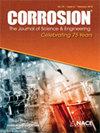优化酸性气体鉴定测试——模拟温度和总压力对H2S逸出量、活性和溶解度系数的影响
IF 1.3
4区 材料科学
Q4 MATERIALS SCIENCE, MULTIDISCIPLINARY
引用次数: 0
摘要
传统上,高压高温油气井的含硫严重程度通过H2S分压(PH2S)来评估:气体中H2S的摩尔分数(yH2S)乘以总压力(PT)。然而,PH2S通常高估了HPHT系统的实际酸性严重程度,导致了次优的材料选择。为了反映热力学建模的最新进展并避免过于保守,经过仔细考虑,ANSI/NACE MR0175-2021/ISO 15156-2:2022最近将酸性严重程度指标的数量扩大到四个:PH2S、逸度(fH2S)、化学活性(aH2S)和水相的溶解浓度(CH2S)。新的度量通常是计算推导的,并考虑到热力学非理想性,这在HPHT条件下是重要的。无论首选指标如何,在进行H2S服务评估时,量化每个指标对大范围温度和总压力的敏感性至关重要。本文研究了温度和总压的升高对热力学推导的H2S表观溶解度(KH2S=CH2S/PH2S)的影响。KH2S是用于量化HPHT系统的H2S相行为/酸性严重程度变化的关键参数。表观KH2S值由两个不同的热力学模型计算,并以两个公开可用的H2S/H2O数据集为基准,在含有165000 mg/L Cl−的盐水中达到120°C和10.3 MPa的平衡。与实验数据最匹配的模型后来被用于更广泛的H2S/CH4/H2O/NaCl“油田”系统的热力学敏感性研究。在该灵敏度分析中,fH2S、aH2S、CH2S和KH2S的变化分别在4至204°C之间、总压力高达138 MPa以及含25 wt%NaCl(180000 mg/L Cl−)的盐水中建模。最后,在相同的温度和总压力参数空间内,通过伪H2S、fH2S和CH2S指标对预测的酸性严重程度进行了比较。本文章由计算机程序翻译,如有差异,请以英文原文为准。
Optimizing Sour Gas Qualification Testing – Modeling the Effects of Temperature and Total Pressure on H2S Fugacity, Activity, and Solubility Coefficients
Traditionally, sour severity of high-pressure, high temperature (HPHT) oil and gas production wells were assessed by H2S partial pressure (PH2S): The mole fraction of H2S in the gas (yH2S) multiplied by the total pressure (PT). However, PH2S usually over-predicts the actual sour severity of HPHT systems, leading to sub-optimal material selection choices. To reflect recent advances in thermodynamic modeling and to avoid over conservatism, after careful deliberation, ANSI/NACE MR0175-2021/ISO 15156-2:2022 recently expanded the number of sour severity metrics to four: PH2S, fugacity (fH2S), chemical activity (aH2S) and dissolved concentration (CH2S) of the aqueous phase. The new metrics are often computationally derived and account for thermodynamic non-idealities, which are significant at HPHT conditions. Regardless of preferred metric, quantifying the sensitivity of each metric to a wide range of temperatures and total pressures is critical when conducting H2S service assessments. In this article, the effect of increasing temperature and total pressure on the thermodynamically derived apparent H2S solubility (KH2S = CH2S/PH2S) was investigated. KH2S is a critical parameter for quantifying changes in H2S phase behavior/sour severity of HPHT systems. Apparent KH2S values were calculated by two different thermodynamic models and benchmarked to two publicly available H2S/H2O datasets up to 120 °C and 10.3 MPa equilibrated in a brine containing 165,000 mg/L Cl−. The model that provided the best match to the experimental data was later used in a much broader thermodynamic sensitivity study of the H2S/CH4/H2O/NaCl “oilfield” system. For this sensitivity analysis, changes in fH2S, aH2S, CH2S and KH2S were individually modeled between 4 to 204 °C, at total pressures up to 138 MPa, and in brines containing up to 25 wt % NaCl (180,000 mg/L Cl−). Lastly, a comparison of the predicted sour severity by pseudo-PH2S, fH2S, and CH2S metrics, over the same temperature and total pressure parameter space, is presented.
求助全文
通过发布文献求助,成功后即可免费获取论文全文。
去求助
来源期刊

Corrosion
MATERIALS SCIENCE, MULTIDISCIPLINARY-METALLURGY & METALLURGICAL ENGINEERING
CiteScore
2.80
自引率
12.50%
发文量
97
审稿时长
3 months
期刊介绍:
CORROSION is the premier research journal featuring peer-reviewed technical articles from the world’s top researchers and provides a permanent record of progress in the science and technology of corrosion prevention and control. The scope of the journal includes the latest developments in areas of corrosion metallurgy, mechanisms, predictors, cracking (sulfide stress, stress corrosion, hydrogen-induced), passivation, and CO2 corrosion.
70+ years and over 7,100 peer-reviewed articles with advances in corrosion science and engineering have been published in CORROSION. The journal publishes seven article types – original articles, invited critical reviews, technical notes, corrosion communications fast-tracked for rapid publication, special research topic issues, research letters of yearly annual conference student poster sessions, and scientific investigations of field corrosion processes. CORROSION, the Journal of Science and Engineering, serves as an important communication platform for academics, researchers, technical libraries, and universities.
Articles considered for CORROSION should have significant permanent value and should accomplish at least one of the following objectives:
• Contribute awareness of corrosion phenomena,
• Advance understanding of fundamental process, and/or
• Further the knowledge of techniques and practices used to reduce corrosion.
 求助内容:
求助内容: 应助结果提醒方式:
应助结果提醒方式:


